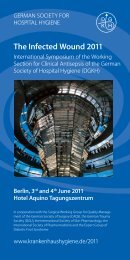Anforderungen an die Hygiene bei der Auf - Deutsche Gesellschaft ...
Anforderungen an die Hygiene bei der Auf - Deutsche Gesellschaft ...
Anforderungen an die Hygiene bei der Auf - Deutsche Gesellschaft ...
Sie wollen auch ein ePaper? Erhöhen Sie die Reichweite Ihrer Titel.
YUMPU macht aus Druck-PDFs automatisch weboptimierte ePaper, die Google liebt.
16<br />
Empfehlung <strong>der</strong> Kommission für Kr<strong>an</strong>kenhaushygiene und Infektionsprävention <strong>bei</strong>m Robert Koch-Institut (RKI)<br />
Recommendation of the Commission for Hospital <strong>Hygiene</strong> <strong>an</strong>d Infection Prevention at the Robert Koch Institute (RKI)<br />
von nicht intakten Hautstellen mit blutigem Speichel ist<br />
<strong>die</strong> Übertragung von z.B. Hepatitis-B-, Hepatitis-C- und<br />
HI-Viren möglich. Bei Kontakt mit Sekreten ist eine Helicobacter-pylori-Übertragung<br />
denkbar. Untersuchungen zur<br />
Seroprävalenz von Antikörpern gegen H. pylori [113, 114,<br />
115] lassen bisher keinen eindeutigen Schluss zu, ob ein<br />
erhöhtes Infektionsrisiko in Endoskopieeinheiten besteht.<br />
Über Kontakt mit Fäzes können Enteritiserreger,Hepatitis-<br />
A-Viren und Cryptospori<strong>die</strong>n übertragen werden. Unter<br />
den durch Blut z.B. <strong>bei</strong> einer Nadelstichverletzung o<strong>der</strong><br />
Verletzung <strong>an</strong> einer Biopsiez<strong>an</strong>ge übertragbaren Mikroorg<strong>an</strong>ismen<br />
sind HBV, HCV und HIV von Bedeutung. Das<br />
Risiko einer Infektionsübertragung durch Nadelstichverletzung<br />
beträgt für Hepatitis B bis zu 30%, für Hepatitis C<br />
ca. 3% und für HIV ca. 0,3% [116]. Unter den berufsbedingten<br />
Risiken für das Endoskopiepersonal muss neben<br />
dem Infektionsrisiko auch das Allergierisiko bedacht<br />
werden. Bis zu 30% des Endoskopiepersonals sind im<br />
Laufe <strong>der</strong> beruflichen Tätigkeit von einer Aldehydallergie<br />
betroffen [97].Ebenso ist das Risiko <strong>der</strong> Latexsensibilisierung<br />
zu berücksichtigen.<br />
Bezüglich <strong>der</strong> zu ergreifenden Maßnahmen des Ar<strong>bei</strong>tsschutzes<br />
unterliegt <strong>der</strong> Endoskopiebereich dem Geltungsbereich<br />
<strong>der</strong> Biostoffverordnung (BioStoffV) [111].<br />
D<strong>an</strong>ach ist eine Gefährdungsbeurteilung zu erstellen, und<br />
entsprechend <strong>die</strong>ser sind <strong>die</strong> erfor<strong>der</strong>lichen Maßnahmen<br />
auszuwählen (§§ 7 ff. Bio StoffV). Bei den Tätigkeiten in<br />
<strong>die</strong>sem Bereich h<strong>an</strong>delt es sich in <strong>der</strong> Regel um nicht<br />
gezielte Tätigkeiten <strong>der</strong> Schutzstufe 2. Für Belastungen<br />
durch chemische Gefahrstoffe (z. B. Desinfektionsmittel)<br />
sind <strong>die</strong> Vorgaben <strong>der</strong> Gefahrstoffverordnung und <strong>der</strong><br />
Unfallverhütungsvorschriften zu beachten (Kategorie IV).<br />
Entsprechend § 15 (Abs. 1) BioStoffV [111] hat <strong>der</strong> Ar<strong>bei</strong>tgeber<br />
Beschäftigte vor <strong>Auf</strong>nahme ihrer Tätigkeit mit biologischen<br />
Ar<strong>bei</strong>tsstoffen nach Anh<strong>an</strong>g IV <strong>der</strong> BioStoffV<br />
ar<strong>bei</strong>tsmedizinisch untersuchen und beraten zu lassen.<br />
Die Untersuchungen sind regelmäßig zu wie<strong>der</strong>holen<br />
sowie am Ende <strong>der</strong> Beschäftigung <strong>an</strong>zubieten. Nach §<br />
15 (Abs. 2) ist Ar<strong>bei</strong>tnehmern <strong>bei</strong> einer Tätigkeit mit biologischen<br />
Ar<strong>bei</strong>tsstoffen <strong>der</strong> Risikogruppe 3 vor <strong>Auf</strong>nahme<br />
ihrer Tätigkeit und d<strong>an</strong>ach in regelmäßigen Abständen<br />
eine ar<strong>bei</strong>tsmedizinische Vorsorgeuntersuchung <strong>an</strong>zubieten.<br />
Dies gilt ebenso für Tätigkeiten mit biologischen<br />
Ar<strong>bei</strong>tsstoffen <strong>der</strong> Risikogruppe 2, es sei denn, dass aufgrund<br />
<strong>der</strong> Gefährdungsbeurteilung und <strong>der</strong> getroffenen<br />
Schutzmaßnahmen nicht mit einem Gesundheitsschaden<br />
zu rechnen ist. Nach § 15 Abs. 4 BioStoffV [111] ist<br />
den Beschäftigten, <strong>die</strong> biologischen Ar<strong>bei</strong>tsstoffen ausgesetzt<br />
sein können, eine Impfung <strong>an</strong>zubieten, wenn ein<br />
wirksamer Impfstoff zur Verfügung steht (z. B. HBV). Die<br />
genaue Vorgehensweise wird in <strong>der</strong> TRBA 300 (Ar<strong>bei</strong>tsmedizinische<br />
Vorsorge) [117] beschrieben. Zusätzliche<br />
Maßnahmen sind über Betriebs<strong>an</strong>weisungen je nach<br />
Gefährdungsbeurteilung zu regeln.<br />
Bezüglich möglicher Maßnahmen zum Personalschutz<br />
in <strong>der</strong> Endoskopie wird auch auf <strong>die</strong> im Anh<strong>an</strong>g 4 aufgeführten<br />
Empfehlungen und Ratschläge verwiesen.<br />
atitis B, hepatitis C <strong>an</strong>d HI viruses for example, is possible<br />
via contact between broken skin spots <strong>an</strong>d bloody<br />
saliva. Helicobacter-pylori-tr<strong>an</strong>smission is conceivable if<br />
there is contact with secretions. Examinations on the<br />
seroprevalence of <strong>an</strong>tibo<strong>die</strong>s against H. pylori [113,<br />
114, 115] do not allow unequivocal conclusions to be<br />
drawn on whether there is <strong>an</strong> increased risk of infection<br />
in endoscopy units. Enteritis pathogens, hepatitis A<br />
viruses <strong>an</strong>d cryptosporidia c<strong>an</strong> be tr<strong>an</strong>smitted through<br />
contact with faeces. HBV, HCV <strong>an</strong>d HIV are the import<strong>an</strong>t<br />
ones among microorg<strong>an</strong>isms, which c<strong>an</strong> be tr<strong>an</strong>smitted<br />
through blood, e.g. in case of a a needlestick<br />
injury or injury with biopsy forceps. The risk of infection<br />
tr<strong>an</strong>smission through needlestick injury amounts to<br />
30% for hepatitis B, 3% for hepatitis C <strong>an</strong>d approximately<br />
0.3% for HIV [116]. Among work-related risks for<br />
endoscopy staff, the allergy risk must be consi<strong>der</strong>ed<br />
next to the risk of infection. Up to 30% of endoscopy<br />
staff are affected by <strong>an</strong> aldehyde allergy in the course of<br />
their career [97]. Likewise, the risk of latex sensitisation<br />
must be given consi<strong>der</strong>ation.<br />
The field of endoscopy is subject to the application of<br />
biological agent regulations (BioStoffV) with regard to<br />
the measures to be taken for industrial safety [111]. They<br />
state that a risk assessment must be made, according<br />
to which the necessary measures are to be selected (§§<br />
7 et seqq. Bio StoffV). The measures in this field are normally<br />
unspecific actions of protection level 2. Regarding<br />
the exposure to chemical hazardous subst<strong>an</strong>ces (e.g.<br />
disinfect<strong>an</strong>ts), the specifications of the hazardous subst<strong>an</strong>ces<br />
legislation <strong>an</strong>d the Accident Prevention Regulation<br />
must be followed (Category IV).<br />
Pursu<strong>an</strong>t to § 15 (para. 1) of the BioStoffV [111], the<br />
employer must ensure employees are examined <strong>an</strong>d<br />
given advice regarding occupational medicine as per<br />
Appendix IV of the BioStoffV before they start working<br />
with biological agents. Examinations must be repeated<br />
regularly <strong>an</strong>d must be offered at the end of employment.<br />
Pursu<strong>an</strong>t to § 15 (para. 2), a preventive occupational<br />
medicine checkup must be offered to employees<br />
working with biological agents of risk group 3, before<br />
they start their jobs <strong>an</strong>d afterwards at regular intervals.<br />
This also holds true for activities with biological agents<br />
pertaining to risk group 2 unless damages to health<br />
are not to be expected according to the risk assessment<br />
<strong>an</strong>d given the protective measures taken. Pursu<strong>an</strong>t<br />
to § 15 para. 4 of the BioStoffV [111], employees<br />
who might be exposed to biological agents must be<br />
offered vaccination if <strong>an</strong> effective vaccine is available<br />
(e.g. HBV). The exact procedure is described in the<br />
Technological Rules for Biological Agents, TRBA 300<br />
(Prevention in terms of Occupational Medicine) [117].<br />
Additional measures have to be set out in operating<br />
instructions in accord<strong>an</strong>ce with risk assessments.<br />
Regarding possible measures for staff protection in<br />
endoscopy, reference is also made to the recommendations<br />
<strong>an</strong>d advice listed in Appendix 4.<br />
Erstmalig veröffentlicht in Bundesgesundheitsbl Gesundheitsforsch – Gesundheitsschutz | first published in Fe<strong>der</strong>al Health Gazette Health Research – Health Protection<br />
2002 • 45:395–411 © Springer-Verlag 2002


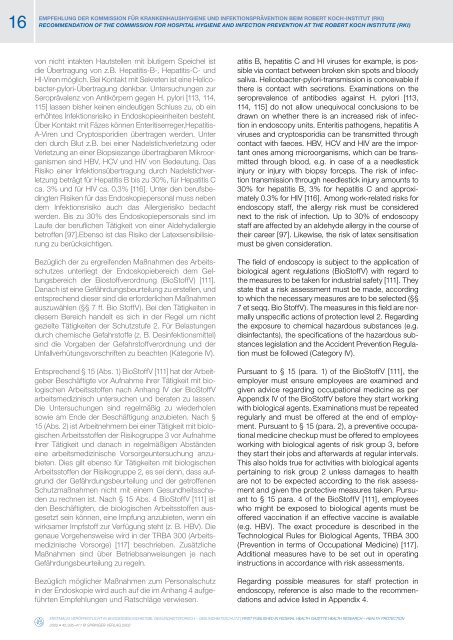
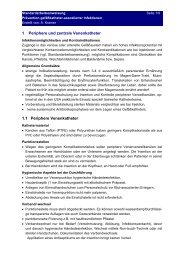
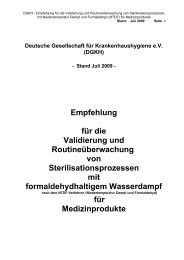


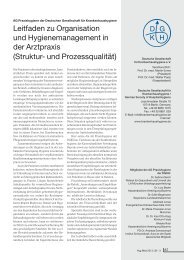

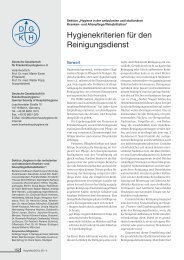


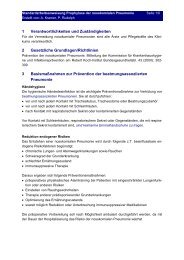

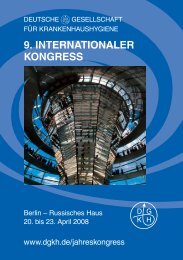
![Hauptprogramm [A4-Quer] - Deutsche Gesellschaft für ...](https://img.yumpu.com/6449478/1/184x260/hauptprogramm-a4-quer-deutsche-gesellschaft-fur-.jpg?quality=85)
